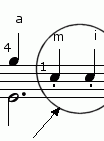
Bach, "Minuet #1" (TAB)
Transcription and Fingering: Renato Bellucci
The greatest musical genius of all time, could simply not let down his wife and millions of fans for many generations to come! What was written as a gift for his wife to improve her keyboard playing, turned into one of the most recognizable melodies ever written. The original key in which Bach wrote the piece is G. I deliberately changed it to C because I know that the tonality renders well on the guitar and allows for greater expression.
Anna Magdalena Bach, was a brilliant professional soprano. She married Johannes at the age of 21. She was the Master's musical confidante, and mother of 11 children. After Sebastian’s death, and left destitute without a will, Anna Magdalena recounts life with her husband and children, her great joy of performing. Maestro Abel Carlevaro gave me her diary to read. It changed my life and my views of the great German master forever. It is the portrayal of female strength and spirited will and the wife of the greatest musical genius ever.
Once again, the master presents us with a simple idea which appears in the first part (the 2 circled notes in the image below). These are to be seen as semi column in writing. The French a very fashionable dance of the Minuet but Bach's masterworks were simply "too beautiful to be danced to". It is known that at certain balls, people would simply stay put and clap at the players after a Bach work was played. When one of Bach's patrons told the master "My guests cannot dance at your dance music!", Bach answered "The thing is that I want them to listen and not to dance".
Recurring musical idea.
Staff and Video 1
These are probably the 4 most recognizable measures of music in the universe.
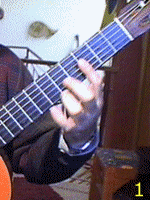
Finger 3 works as a guide in the change of position in measure 3. It also acts as pivot by allowing the left hand to rotate and help finger 2 to reach the E on string 5.
Notice how the forearm pushes the wrist forward forcing the bend at the main joint between the arm and the left hand.
Video 1
Staff and Video 2
You can pause for a short period of time after playing the D in measure 4 and than make up for the time by speeding up the G-F-E-D sequence.
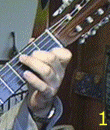
With hammer ons, the best approach is to literally think of a hammer. Lift the finger slightly above the fret where you immediately and swiftly after, hit the string (very close to the fret) in order to produce the legato (tied) sounding note. Practice every move in slow motion before attempting to do it at normal speed.

With pull offs, press on the string... bring the finger downwards, parallel to the fingerboard, as soon as the sound is produced return to the original presentation. The whole movement of the finger (finger 4 in this particular case) is like drawing a circle in the air.
Video 2
Staff and Video 3
Essentially, this is a varied repetition of the first section. Pay attention to the highlighted section at the beginning of the video where I show how the right hand performs the 5 strings "arpeggiated chord". I use the thumb for strings 5 and 4 and the index, middle and ring fingers for the remaining strings.
Breathe whenever you are challenged to a major position change on the fingerboard in order to release the muscular tension.
Video 3
Staff and Video 4
Fingers 1 and 2 which stop the E and C in measure 3, perform a double ascending legato to play the open D and B. Use fijacion, to move the 2 fingers in conjunction.
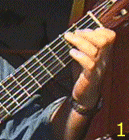
Finger 1, which stops the C, acts like a pivot around which the hand rotates to present the F/D double stop
Video 4
Staff and Video 5
The guitar allows for a lot of expression. Sing the high E and D in measures 1 and 2 respectively. Use the C stopped by finger 2 in measure 3 to act like a pivot to help you present the G on string 2. Look how I slide fingers 1 and 3 to unify the melody during the fret changes.
Where I write "LEVER", the fingers becomes the point of equilibrium of the left hand, the weigh is shifted onto it. The fingers are presented on the fingerboard with ease as long as the left hand has support. June 26,2013: Lately I have been using the fingering in GREEN
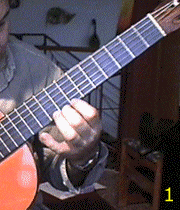
The hand rotates around the C using finger 2 as a pivot (measure 3).
Video 5
Revision: Santa Monica, CA, December 3, 2012
 Back to Top
Back to Top
